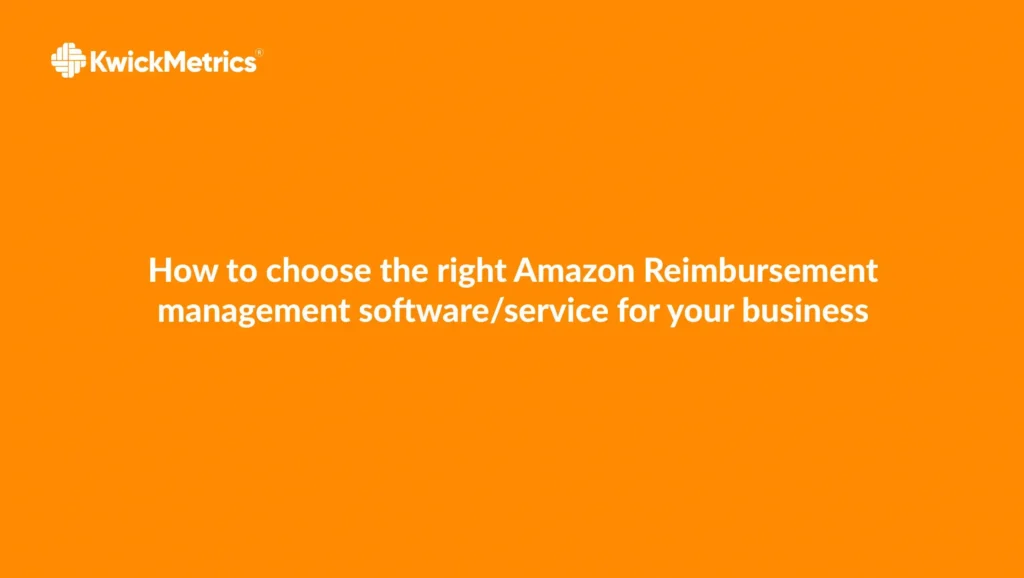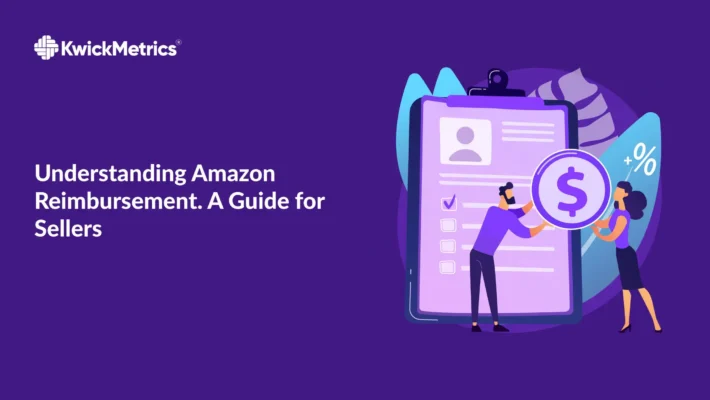How to choose the right Amazon Reimbursement management software/service for your business

Table of Contents
- What steps should I follow to find the right Amazon reimbursement software/service for me?
- Check How Much Money You Deserve to Get Back!
- Try our Amazon Analytics Tool with a 14-day Free Trial!
- Which Amazon reimbursement software/service is right for your business?
- KwickMetrics Amazon Reimbursement Service - Your Key to Maximise Profits!
Are you facing challenges in selecting from a variety of reimbursement service providers, each offering distinct features and pricing? Do you find it difficult to understand what each service provides in terms of coverage for reimbursement use cases, claim automation, analytics, reporting capabilities, and customer support? If so, you’re not alone—many encounter similar difficulties.
At KwickMetrics, we’ve connected with hundreds of Amazon sellers over the years. From these conversations, we’ve learned what Amazon sellers are looking for and the questions they ask about KwickMetrics (and other options). These conversations have given us the ability to put together a comprehensive step by step process to make sure you select the right choice for you (even if it’s not us).
After reading this article, you’ll know how to select the ideal Amazon reimbursement management software/service to enhance your business’s financial well-being, enabling you to optimize revenue recovery and streamline operational efficiency.
What steps should I follow to find the right Amazon reimbursement software/service for me?
Step 1 – Understand your needs and business requirements
Before exploring different options, it’s crucial to understand your specific needs and pain points:
-
- Volume of Transactions – Evaluate the number of transactions your business processes each month. For high-volume sellers, it’s essential to have a robust, automated solution that ensures no reimbursement opportunity is overlooked. These solutions can handle large data sets efficiently, providing real-time insights and minimizing manual errors. On the other hand, if your transaction volume is lower, you might find simpler tools or self-service options sufficient, allowing you to manage reimbursements without the complexity or cost of advanced software.
-
- Budget – Establish a clear budget for your reimbursement management needs. Seek scalable solutions that fit within your financial plan, ensuring you get the best value for your investment. Opt for services with transparent pricing models and performance-based fees, which align costs with actual recoveries, maximizing your return on investment. This approach ensures you only pay for the value you receive, making it a more sustainable and cost-effective choice for your business.
-
- In-house Capabilities – Assess your team’s capacity and expertise in managing reimbursements. If your team lacks the time, skills, or resources to handle this process effectively, outsourcing may be a strategic move. Specialized services can take over the entire reimbursement process, from auditing to claim submission and follow-up. This not only frees up your internal resources but also ensures that your reimbursement claims are handled by experts who stay up-to-date with Amazon’s policies and procedures, increasing the likelihood of successful recoveries.
Step 2 – Understand the different types of Amazon reimbursement services
When selecting Amazon reimbursement management services, it’s essential to understand the distinct offerings tailored to different seller needs and operational efficiencies:
Self-managed reimbursement
-
- Cost of the approach- Free, unless you need to hire someone to manage the process.
-
- Advantages of self-managed reimbursement – Provides complete control over the reimbursement process without additional costs.
-
- Considerations of self-managed reimbursement – Requires significant time investment and in-depth knowledge of Amazon’s policies. Sellers manage tasks such as auditing accounts, submitting claims, and handling denials manually. This approach suits sellers with internal resources dedicated to reimbursement management.
Subscription-based tools
-
- Cost of the tool – Typically a monthly or annual subscription fee.
-
- Advantages of the tool – These tools automate auditing processes, simplify claim submissions, and provide detailed reporting, offering predictable costs.
-
- Considerations of the tool – Sellers should be aware of ongoing expenses, irrespective of reimbursement outcomes. For instance, tools like Helium 10 Refund Genie and SellerBoard often bundle additional features and analytics alongside reimbursement services in their subscription packages. This requires sellers to invest time in managing these bundled features, potentially detracting from cost efficiency and resource allocation.
-
- Examples – Helium 10 Refund Genie and SellerBoard.
Commission-based professional services
-
- Cost of the service – Typically involves a commission ranging from 10% to 25% on recovered funds.
-
- Advantages of the service – These services offer comprehensive management of reimbursement processes, including auditing, claim filing, and follow-up. Sellers only pay when funds are successfully recovered, which aligns their costs with their revenue gains. Moreover, these services require minimal involvement from sellers, allowing them to focus on core business activities.
-
- Considerations of the service – Sellers should note that the cost is calculated as a percentage of recovered funds, which can be higher compared to other fee structures. The effectiveness and efficiency of these services may vary between providers, impacting the amount recovered and the speed of reimbursement.
-
- Examples – Getida, and KwickMetrics. These providers are known for their expertise in navigating Amazon’s complex reimbursement processes, ensuring convenience and maximizing recovery opportunities for sellers.
If your Amazon store has almost no discrepancies or if your sales volume is under 100 orders per month and you’re willing to allocate internal staff time to managing reimbursements, then self-managed claims may be the best choice for you.
If your Amazon store has a moderate order volume and your dedicated in-house team needs assistance with detailed data filtering and visual analytics, and if your in-house team has experts who is capable of continuous follow-ups with the raised cases, then subscription-based tools are a suitable choice.
If you don’t have a team and don’t have time to manage reimbursements due to other business responsibilities, commission-based services are ideal. They handle everything on your behalf, ensuring tension-free reimbursement management for a percentage of the recovered funds.
Based on your business requirements, choose the option that best suits your needs.
Step 3 – Evaluate key factors of the software/service
When assessing reimbursement management services, it’s crucial to consider several critical features that can significantly impact your business’s financial health and operational efficiency:
-
- Advanced algorithm of the software – Seek tools that leverage sophisticated algorithms to integrate and analyze data comprehensively. These algorithms prioritize incidents, automate tasks, and identify reimbursement opportunities over extended periods (up to 18 months). This capability minimizes financial losses by efficiently managing reimbursement processes.
-
- Daily audits – Regular account audits are essential for promptly identifying new reimbursement opportunities. These audits update expiry dates, monitor case statuses, and ensure timely claims and follow-ups. This proactive approach prevents potential losses and maximizes reimbursement recovery.
-
- Reimbursement case coverage – Verify that the software covers a broad spectrum of reimbursement scenarios. This should include discrepancies in inventory, overcharged fees, and support for both Fulfillment by Amazon (FBA) and Fulfilled by Merchant (FBM) sellers. Comprehensive coverage ensures financial accuracy and maximizes reimbursements across different seller types.
-
- Marketplace support – Strong marketplace support across all Amazon marketplaces is critical. It minimizes the risk of missing reimbursement opportunities and effectively manages diverse selling platforms. This feature ensures that sellers can optimize their financial recovery efforts across various regions and platforms.
-
- Data security – Robust data security protocols within Amazon reimbursement software are essential. They safeguard against unauthorized access, maintain the confidentiality of sensitive information, and ensure compliance with Amazon’s stringent standards. This enhances trust and confidence in the software’s reliability and security measures.
-
- User-friendly interface – Enhance reimbursement management with an intuitive interface that offers easy navigation, category-specific insights, streamlined case tracking, customizable options, and clear data presentation. A user-friendly interface simplifies operations and enhances the overall user experience, making it easier to manage reimbursement processes effectively.
-
- Expertise in handling all cases – Look for providers with a knowledgeable team experienced in managing all types of reimbursement cases. This includes specialized knowledge of Amazon’s reimbursement policies, diverse claim types, effective navigation of Seller Central, and strategic claim submissions. Expertise in these areas ensures optimal financial recovery and minimizes administrative burden on sellers.
Check How Much Money You Deserve to Get Back!
Step 4 – Research the reputation and reviews of the software/service
When evaluating reimbursement service providers, thorough research into their reputation is crucial for making informed decisions that positively impact your business’s financial health and operational efficiency:
-
- Customer reviews – Explore feedback from fellow Amazon sellers to understand their firsthand experiences with the service. Reviews offer insights into the reliability, effectiveness, and overall satisfaction levels of the reimbursement service. This real-world feedback helps gauge how well the service meets the needs and expectations of sellers like yourself.
-
- Case studies – Look for case studies or success stories that showcase how the service has effectively helped other sellers recover lost funds and enhance their profitability. These examples illustrate practical applications of the service’s capabilities and provide tangible evidence of its impact on business outcomes. Case studies can highlight specific challenges faced by sellers and how the service resolved them, offering valuable insights into its effectiveness.
-
- Industry recognition – Consider choosing a service that is authorized by Amazon and listed on the Amazon Selling Partner App Store. This recognition indicates compliance with Amazon’s standards and demonstrates the service’s reliability and alignment with platform requirements. It assures that the service has been vetted by Amazon and is endorsed for its quality and adherence to industry best practices.
Step 5 – Check for trial periods and contract flexibility of the software/service
When choosing Amazon reimbursement management software, it’s essential to prioritize providers that offer the following features to ensure you make the best decision for your business:
-
- Free audit – Before committing to any software, take advantage of providers that offer a free audit. This preliminary assessment is crucial for identifying potential reimbursements that may have been overlooked, evaluating the accuracy of the software in detecting and processing reimbursement opportunities, and estimating the financial impact of recoverable amounts. A free audit empowers sellers to make informed decisions by providing concrete data on the potential benefits of using the software.
-
- Flexible contracts – Opt for providers that offer flexible contract terms rather than rigid, long-term commitments. Flexibility in contracts allows you to adjust or switch services as your business needs evolve over time. This freedom is particularly valuable as it accommodates changes in business scale, operational requirements, or shifts in strategic priorities without being tied down to a lengthy contract. It ensures that your reimbursement management solution can adapt to your business’s changing dynamics and requirements effectively.
Try our Amazon Analytics Tool with a 14-day Free Trial!
Step 6 – Analyze the cost vs. value of the software/service
While cost is an important consideration, the value provided by the reimbursement management service should be your primary focus:
-
- ROI Calculation – Compare the cost of the service to the amount of funds recovered to determine the return on investment (ROI). A higher initial cost might be justified if the service significantly increases your recovery rate. Calculating ROI helps you understand the financial benefits the service brings to your business.
-
- Additional Benefits – Evaluate additional benefits such as time savings, improved accuracy, and peace of mind. Effective reimbursement management software should automate tasks, saving you time and allowing you to focus on other aspects of your business. Accurate claim processing reduces the risk of missed reimbursements, and knowing that your claims are handled efficiently provides peace of mind.
Which Amazon reimbursement software/service is right for your business?
Understand how to choose the right Amazon reimbursement management software/service. Choosing the best reimbursement service can be challenging due to different features and prices. It’s difficult to understand what each service offers in terms of automating claims, analytics, and support.
To make a smart decision, consider your needs, research reputable providers, and explore trial options. This ensures you select a service that maximizes your financial recovery efficiently. Selecting the ideal Amazon reimbursement software/service can be daunting, especially when dealing with complex refunds and aiming to recover funds effectively. After you find the right reimbursement service/software for you, your next step is to go through a trial.
Some general advice when going through a trial includes thoroughly testing all features, monitoring the accuracy of reimbursements, evaluating the ease of use, checking the responsiveness of customer support, and assessing the software’s impact on your business processes. If you’re interested in how to get the most out of a trial with KwickMetrics, we’ve written this article to help you.




